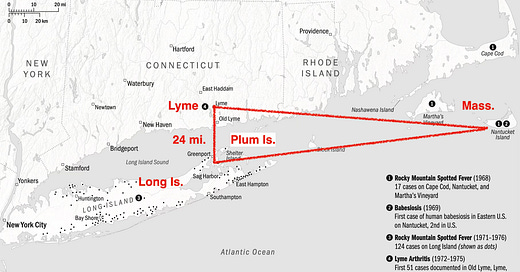Stranger Things About the Lyme Outbreak
Why did 3 unusual tick-borne diseases suddenly appear around Long Island in the late 60s?
In the late 60s, a sudden outbreak of three unusual tick-borne diseases sickened people living around Long Island Sound, an estuary of the Atlantic Ocean off the shores of New York and Connecticut. One of these diseases was Lyme arthritis, first documented near the township of Lyme, Connecticut. The other two were Rocky Mountain Spotted Fever, a bacterial disease, and babesiosis, a bovine parasite that had recently jumped to humans. (There were also anomalous outbreaks of duck plague and equine encephalitis, which I’ll discuss later on.)
The investigations into these outbreaks were fragmented among multiple state health departments, universities, and government labs. It’s not clear if anyone was looking at the big picture, asking why these strange diseases appeared, seemingly out of nowhere, in the same place and at the same time.
After 13 years of investigations, a Swiss American NIH tick expert, Willy Burgdorfer, solved part of the mystery. He identified the corkscrew-shaped bacteria that caused the swollen joints and expanding rashes caused by what we now call Lyme disease. But the other two diseases dropped off everyone’s radar.
It seems that this triple threat would’ve set off alarms at the CDC, the agency that monitors potential bioweapons attacks, but there are no public-facing documents on this.
Ex-Colonel Zygmunt F. Dembek, PhD, MS, MPH, a medical preparedness consultant at Battelle who teaches courses on biological warfare, discussed his top five alarm bells in the article, “Discernment Between Deliberate and Natural Infectious Disease Outbreaks.”
Clue no. 1—A highly unusual event with large numbers of casualties.
Clue no. 2—Higher morbidity or mortality than is expected.
Clue no. 3—Uncommon disease.
Clue no. 4—Point-source outbreak.
Clue no. 5—Multiple epidemics.
The Lyme-area outbreak checks off all five. Rocky Mountain Spotted Fever was in development as an airborne bioweapon during the Cold War, with hundreds of Long Islanders infected at the peak of the bioweapons program. Babesia, a spillover animal parasite, killed several people in Massachusetts, in an area suspiciously close to the former center for anti-animal bioweapons research, Plum Island. Then there’s Lyme disease—and who knows where this virulent strain came from—which continues to spread and cause chronic neurological symptoms in people.
Adding fuel to this theory of unnatural outbreaks is the fact that the Lyme disease discoverer, Dr. Burgdorfer, told me and a documentary producer that he believed that the outbreak could be related to biological weapons. Documents show that he worked for the biological weapons program in the fifties and sixties.
“Accidents happen” and “Sometimes experiments don’t turn out as planned” are two things Dr. Burgdorfer said in the interviews. He also said he was asked to bury another suspicious microbe he identified during his investigation, which I labeled “Swiss Agent USA.”
My book “Bitten” reveals that our military conducted hundreds, if not thousands, of experiments exploring the use of ticks and tick-borne diseases as weapons—and some of these agents may have escaped. If the Lyme-area sickness was caused by a bioweapons release of one or more agents, we need to be addressing our tick-borne disease problem in a wholly different way. If it was a hostile act by a foreign actor, we need better protections in the future.
###
Kris Newby is an award-winning medical science writer and the senior producer of the Lyme disease documentary UNDER OUR SKIN. Her book BITTEN: The Secret History of Lyme Disease and Biological Weapons won three international book awards for journalism and narrative nonfiction. Previously, Newby worked for Stanford Medical School, Apple, and other Silicon Valley companies.
If you've found this content useful, please consider supporting it through a small paid subscription. While my posts are free, your paid subscription helps underwrite this independent research. It also helps keep it free for those who cannot afford to pay.





These last few years I feel like I've swallowed a lot of red pills, between the whole Covid fiasco, reading Snowdon's book, hearing Bobby Kennedy Jr. speaking about the CIA's involvement in both his father's and his uncle's deaths. And then, Kris Newby, I read your book. It's just shattering, to learn about not only the dangerous experiments our government has been performing, but how reckless they have been and continue to be, and how they bury their guilt to cover up their deeds. Thank you for writing such a compelling and easy to read exposition of the Lyme epidemic and its roots. Sunlight is the best disinfectant, and I hope and pray that your shedding light on this will help to bring it all out in the open and that it will eventually lead to better care for Lyme sufferers.
I can interview you and give you a huge platform...you need to reach me...